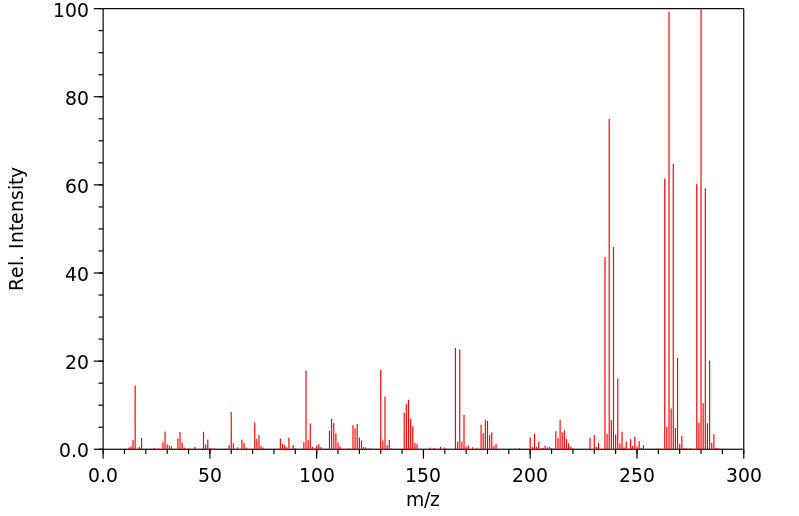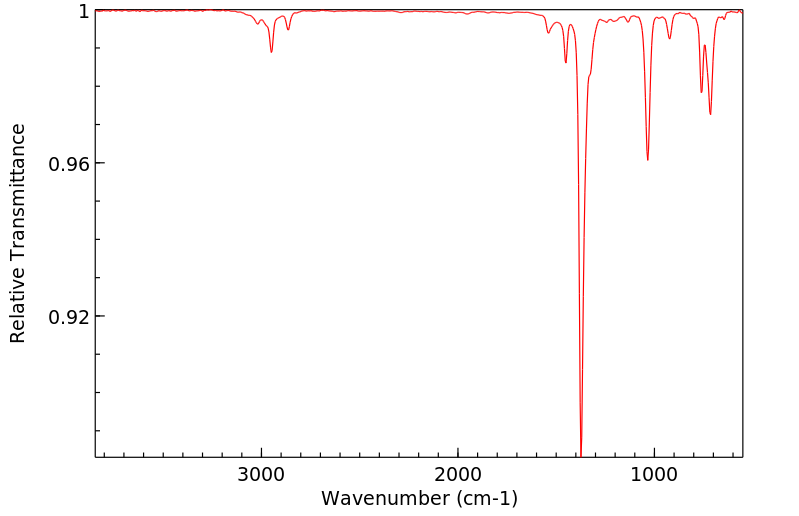五氯甲氧基苯 | 1825-21-4
-
物化性质
-
计算性质
-
ADMET
-
安全信息
-
SDS
-
制备方法与用途
-
上下游信息
-
文献信息
-
表征谱图
-
同类化合物
-
相关功能分类
-
相关结构分类
物化性质
-
熔点:108-110℃
-
沸点:309℃ (760 Torr)
-
密度:1.6178 (estimate)
-
溶解度:可溶于氯仿、甲醇(少许)
-
物理描述:Pentachloroanisole appears as needles or white crystals. (NTP, 1992)
-
味道:Oily, muddy
-
保留指数:1690;1724;1741;1681;1699;1721;1719;1672;1699.7
-
稳定性/保质期:
如果按照规格使用和储存,则不会分解,没有已知危险反应,应避免与氧化物接触。
计算性质
-
辛醇/水分配系数(LogP):5.4
-
重原子数:13
-
可旋转键数:1
-
环数:1.0
-
sp3杂化的碳原子比例:0.142
-
拓扑面积:9.2
-
氢给体数:0
-
氢受体数:1
ADMET
安全信息
-
危险等级:6.1(b)
-
危险品标志:Xn
-
危险类别码:R22
-
海关编码:2909309090
-
包装等级:III
-
危险类别:6.1(b)
-
危险品运输编号:UN 2811
-
储存条件:密封,在0-6 ºC下保存
SDS
模块 1. 化学品
1.1 产品标识符
: 五氯苯甲醚
产品名称
: Supelco
1.2 鉴别的其他方法
2,3,4,5,6-PeNTAhref=https://www.molaid.com/MS_112097 target="_blank">NTachloroanisole
1.3 有关的确定了的物质或混合物的用途和建议不适合的用途
仅用于研发。不作为药品、家庭或其它用途。
模块 2. 危险性概述
2.1 GHS-分类
急性毒性, 经口 (类别 4)
急性水生毒性 (类别 1)
2.2 GHS 标记要素,包括预防性的陈述
象形图
警示词 警告
危险申明
H302 吞咽有害。
H400 对水生生物毒性极大。
警告申明
预防措施
P264 操作后彻底清洁皮肤。
P270 使用本产品时不要进食、饮水或吸烟。
P273 避免释放到环境中。
事故响应
P301 + P312 如果吞咽并觉不适: 立即呼叫解毒中心或就医。
P330 漱口。
P391 收集溢出物。
废弃处置
P501 将内容物/ 容器处理到得到批准的废物处理厂。
2.3 其它危害物 - 无
模块 3. 成分/组成信息
3.1 物 质
: 2,3,4,5,6-PeNTAhref=https://www.molaid.com/MS_112097 target="_blank">NTachloroanisole
别名
: C7H3Cl5O
分子式
: 280.36 g/mol
分子量
组分 浓度或浓度范围
2,3,4,5,6-PeNTAhref=https://www.molaid.com/MS_112097 target="_blank">NTachloroanisole
<=100%
化学文摘登记号(CAS 1825-21-4
No.)
模块 4. 急救措施
4.1 必要的急救措施描述
一般的建议
请教医生。 向到现场的医生出示此安全技术说明书。
吸入
如果吸入,请将患者移到新鲜空气处。 如呼吸停止,进行人工呼吸。 请教医生。
皮肤接触
用肥皂和大量的水冲洗。 请教医生。
眼睛接触
用水冲洗眼睛作为预防措施。
食入
切勿给失去知觉者通过口喂任何东西。 用水漱口。 请教医生。
4.2 主要症状和影响,急性和迟发效应
据我们所知,此化学,物理和毒性性质尚未经完整的研究。
4.3 及时的医疗处理和所需的特殊处理的说明和指示
无数据资料
模块 5. 消防措施
5.1 灭火介质
灭火方法及灭火剂
用水雾,抗乙醇泡沫,干粉或二氧化碳灭火。
5.2 源于此物质或混合物的特别的危害
碳氧化物, 氯化氢气体
5.3 给消防员的建议
如必要的话,戴自给式呼吸器去救火。
5.4 进一步信息
无数据资料
模块 6. 泄露应急处理
6.1 作业人员防护措施、防护装备和应急处置程序
使用个人防护用品。 避免粉尘生成。 避免吸入蒸气、烟雾或气体。 保证充分的通风。
人员疏散到安全区域。 避免吸入粉尘。
6.2 环境保护措施
如能确保安全,可采取措施防止进一步的泄漏或溢出。 不要让产品进入下水道。
一定要避免排放到周围环境中。
6.3 泄漏化学品的收容、清除方法及所使用的处置材料
收集和处置时不要产生粉尘。 扫掉和铲掉。 放入合适的封闭的容器中待处理。
6.4 参考其他部分
丢弃处理请参阅第13节。
模块 7. 操作处置与储存
7.1 安全操作的注意事项
避免接触皮肤和眼睛。 避免形成粉尘和气溶胶。
在有粉尘生成的地方,提供合适的排风设备。
7.2 安全储存的条件,包括任何不兼容性
贮存在阴凉处。 使容器保持密闭,储存在干燥通风处。
7.3 特定用途
无数据资料
模块 8. 接触控制和个体防护
8.1 容许浓度
最高容许浓度
没有已知的国家规定的暴露极限。
8.2 暴露控制
适当的技术控制
根据良好的工业卫生和安全规范进行操作。 休息前和工作结束时洗手。
个体防护设备
眼/面保护
带有防护边罩的安全眼镜符合 EN166要求请使用经官方标准如NIOSH (美国) 或 EN 166(欧盟)
检测与批准的设备防护眼部。
皮肤保护
戴手套取 手套在使用前必须受检查。
请使用合适的方法脱除手套(不要接触手套外部表面),避免任何皮肤部位接触此产品.
使用后请将被污染过的手套根据相关法律法规和有效的实验室规章程序谨慎处理. 请清洗并吹干双手
所选择的保护手套必须符合EU的89/686/EEC规定和从它衍生出来的EN 376标准。
身体保护
全套防化学试剂工作服, 防护设备的类型必须根据特定工作场所中的危险物的浓度和数量来选择。
呼吸系统防护
如须暴露于有害环境中,请使用P95型(美国)或P1型(欧盟 英国
143)防微粒呼吸器。如需更高级别防护,请使用OV/AG/P99型(美国)或ABEK-P2型 (欧盟 英国 143)
防毒罐。
呼吸器使用经过测试并通过政府标准如NIOSH(US)或CEN(EU)的呼吸器和零件。
模块 9. 理化特性
9.1 基本的理化特性的信息
a) 外观与性状
形状: 固体
b) 气味
无数据资料
c) 气味阈值
无数据资料
d) pH值
无数据资料
e) 熔点/凝固点
熔点/凝固点: 107 - 109 °C
f) 沸点、初沸点和沸程
无数据资料
g) 闪点
无数据资料
h) 蒸发速率
无数据资料
i) 易燃性(固体,气体)
无数据资料
j) 高的/低的燃烧性或爆炸性限度 无数据资料
k) 蒸气压
无数据资料
l) 蒸汽密度
无数据资料
m) 密度/相对密度
无数据资料
n) 水溶性
无数据资料
o) n-辛醇/水分配系数
无数据资料
p) 自燃温度
无数据资料
q) 分解温度
无数据资料
r) 粘度
无数据资料
模块 10. 稳定性和反应活性
10.1 反应性
无数据资料
10.2 稳定性
无数据资料
10.3 危险反应
无数据资料
10.4 应避免的条件
无数据资料
10.5 不相容的物质
强氧化剂
10.6 危险的分解产物
其它分解产物 - 无数据资料
模块 11. 毒理学资料
11.1 毒理学影响的信息
急性毒性
半数致死剂量 (LD50) 经口 - 小鼠 - 318 mg/kg
备注: 行为的:嗜睡(全面活力抑制)。 行为的:震颤。 行为的:肌肉无力
皮肤刺激或腐蚀
无数据资料
眼睛刺激或腐蚀
无数据资料
呼吸道或皮肤过敏
无数据资料
生殖细胞致突变性
细胞突变性-体外试验 - 小鼠 - 淋巴细胞
微生物突变
致癌性
致癌性 - 大鼠 - 经口
肿瘤发生:符合RTECS标准的成瘤性。 内分泌的:肿瘤
该产品不是或不包含被IARC, ACGIH, EPA, 和 NTP 列为致癌物的组分
IARC:
此产品中没有大于或等于 0。1%含量的组分被 IARC鉴别为可能的或肯定的人类致癌物。
生殖毒性
生殖毒性 - 大鼠 - 经口
对生殖的影响:胚胎植入后死亡率(例如总着床胚胎数中死亡和/或被再吸收的胚胎数)。
对生殖的影响:数量少(例如#每胎产仔;出生前测定)。
发育毒性 - 大鼠 - 经口
对胚胎或胎儿的影响:胎儿毒性(死亡除外,例如矮小胎儿)。
特异性靶器官系统毒性(一次接触)
无数据资料
特异性靶器官系统毒性(反复接触)
无数据资料
吸入危险
无数据资料
潜在的健康影响
吸入 吸入可能有害。 可能引起呼吸道刺激。
摄入 误吞对人体有害。
皮肤 通过皮肤吸收可能有害。 可能引起皮肤刺激。
眼睛 可能引起眼睛刺激。
接触后的征兆和症状
据我们所知,此化学,物理和毒性性质尚未经完整的研究。
附加说明
化学物质毒性作用登记: BZ8820000
模块 12. 生态学资料
12.1 生态毒性
对鱼类的毒性 半数致死浓度(LC50) - 肥头鲦鱼 (黑头软口鲦鱼) - 0.65 mg/l - 96 h
对水蚤和其他水生无脊 死亡率 半数效应浓度(EC50) - 大型蚤 (水蚤) - 0.027 mg/l - 48 h
椎动物的毒性
12.2 持久性和降解性
无数据资料
12.3 潜在的生物累积性
无数据资料
12.4 土壤中的迁移性
无数据资料
12.5 PBT 和 vPvB的结果评价
无数据资料
12.6 其它不良影响
对水生生物毒性极大。
无数据资料
模块 13. 废弃处置
13.1 废物处理方法
产品
将剩余的和不可回收的溶液交给有许可证的公司处理。
与易燃溶剂相溶或者相混合,在备有燃烧后处理和洗刷作用的化学焚化炉中燃烧
受污染的容器和包装
按未用产品处置。
模块 14. 运输信息
14.1 联合国危险货物编号
欧洲陆运危规: 3077 国际海运危规: 3077 国际空运危规: 3077
14.2 联合国运输名称
欧洲陆运危规: ENVIRONMENTALLY HAZARDOUS SUBSTANCE, SOLID, N.O.S. (2,3,4,5,6-
PeNTAhref=https://www.molaid.com/MS_112097 target="_blank">NTachloroanisole)
国际海运危规: ENVIRONMENTALLY HAZARDOUS SUBSTANCE, SOLID, N.O.S. (2,3,4,5,6-
PeNTAhref=https://www.molaid.com/MS_112097 target="_blank">NTachloroanisole)
国际空运危规: EnvironmeNTAhref=https://www.molaid.com/MS_112097 target="_blank">NTally hazardous subSTance, solid, n.o.s. (2,3,4,5,6-PeNTAhref=https://www.molaid.com/MS_112097 target="_blank">NTachloroanisole)
14.3 运输危险类别
欧洲陆运危规: 9 国际海运危规: 9 国际空运危规: 9
14.4 包裹组
欧洲陆运危规: III 国际海运危规: III 国际空运危规: III
14.5 环境危险
欧洲陆运危规: 是 国际海运危规 国际空运危规: 是
海洋污染物(是/否): 是
14.6 对使用者的特别提醒
进一步信息
危险品独立包装,液体5升以上或固体5公斤以上,每个独立包装外和独立内包装合并后的外包装上都必须有EHS
标识 (根据欧洲 ADR 法规 2.2.9.1.10, IMDG 法规 2.10.3),
模块 16. 其他信息
进一步信息
上述信息视为正确,但不包含所有的信息,仅作为指引使用。本文件中的信息是基于我们目前所知,就正
确的安全提示来说适用于本品。该信息不代表对此产品性质的保证。
参见发票或包装条的反面。
模块 15 - 法规信息
N/A
制备方法与用途
类别:农药
毒性分级:高毒
急性毒性(口服)- 小鼠 LD50: 318 毫克/公斤
可燃性危险特性:燃烧时产生有毒氯化物气体
储运特性:需在库房内通风、低温和干燥条件下储存运输,并与食品原料分开存放
灭火剂:干粉、泡沫或砂土
上下游信息
反应信息
-
作为反应物:描述:参考文献:名称:Barber et al., Journal of Applied Chemistry, 1953, vol. 3, p. 409,411摘要:DOI:
-
作为产物:描述:参考文献:名称:五烷基胍作为醚化和酯化催化剂摘要:已经制备了几种五烷基胍,并且发现它们是用于由碳酸盐制备芳基和芳烷基醚以及用于苯酚与碳酸二甲酯甲基化的优良催化剂。它们也可作为有效的催化剂,用于酸与烷基氯甲酸酯的酯化反应,而不是叔醇与乙酸酐的乙酰化反应。DOI:10.1016/s0040-4020(01)89753-2
文献信息
-
[EN] IONIC LIQUID SUPPORTED ORGANOTIN REAGENTS FOR THE MANUFACTURING OF RADIOPHARMACEUTICALS COMPOUNDS<br/>[FR] RÉACTIFS ORGANOSTANNIQUES SUPPORTÉS SUR LIQUIDE IONIQUE POUR LA PRODUCTION DE COMPOSÉS RADIOPHARMACEUTIQUES申请人:CENTRE NAT RECH SCIENT公开号:WO2015104300A1公开(公告)日:2015-07-16The present invention relates to an ionic liquid supported organotin reagent of formula (I). The invention further relates to a process for manufacturing the ionic liquid supported organotin reagent of formula (I) and to a process for manufacturing an halogenated or radio-halogenated compound using compound of formula (I). The invention also relates to a device for implementing the halogenating process of the invention and to a kit comprising the compound of formula (I).
-
Compounds Useful as Metal Chelators申请人:Tweedle Michael F.公开号:US20080124270A1公开(公告)日:2008-05-29New compounds are provided that may be used to chelute a metal. The compound comprise polyazamacrocyclic compound with at least one phosphonic group substituted on at least one of the aza groups of the polyazamacrocyclic compound. Methods for preparing the compounds are also provided. Methods for preparing a diagnostic imaging agent using the compounds and methods for diagnostic imaging are further provided. Methods for preparing a therapeutic agent using the compounds and methods for therapy are further provided.提供了可以用于螯合金属的新化合物。该化合物包括至少在多氮杂大环化合物的一个氮杂基上取代至少一个膦基的聚氮杂大环化合物。还提供了制备这些化合物的方法。进一步提供了利用这些化合物制备诊断成像剂的方法以及诊断成像的方法。还提供了利用这些化合物制备治疗剂的方法以及治疗的方法。
-
Electroreduction of Organic Compounds, 34 [1]. Cathodic Dehalogenation of Chloroarenes with Electron-Donating Substituents作者:Olaf Kranz、Jürgen VossDOI:10.1515/znb-2003-1206日期:2003.12.1
The electrochemical reduction of chlorinated arenes with electron-donating substituents, i. e. chlorotoluenes, -anisoles and -phenols, is studied. Preparative electrolyses are run in various solventsupporting electrolytes under potentiostatic and galvanostatic conditions at lead or carbon cathodes. A partial and mostly regioselective hydrodechlorination of compounds with two or more chloro substituents is possible under suitable conditions. The replacement of one single chloro substituent, in particular in a para-position, is difficult. Highly toxic and persistent oligochloro derivatives are thus transformed into less problematic compounds with a low degree of chlorination. The chlorine content of real-life materials such as extracts of soil contaminated with chlorinated phenols and Nitrofen® can also be significantly decreased by electroreduction.
-
Disposition and metabolism of radiolabelled pentachloroanisole in rats and rabbits作者:G.J. Ikeda、P.P. Sapienza、P.I. WarrDOI:10.1016/0278-6915(94)90129-5日期:1994.12in rats and averaged 6 hr in rabbits. Rats excreted an average of 54.2% of the administered radiolabel in the urine and 32.4% in the faeces during the 96 hr following the dose; rabbits excreted an average of 84.2 and 13.1% of the radiolabel in the urine and faeces, respectively, during this time. Examination of the metabolites in the rat showed that 60% of the urinary radioactivity was attributable通过强饲法给雄性Sprague-Dawley大鼠和新西兰白兔在玉米油中的14C标记五氯茴香醚(PCA)进行单次剂量25 mg / kg的给药,然后在各个代谢笼中放置长达4天。向大鼠给药后6小时和兔子在3至4小时之间出现峰值血放射性。消除血液的半衰期在大鼠中为8到15小时,在兔子中平均为6小时。在服药后的96小时内,大鼠平均排泄了尿液中54.2%的放射性标记和32.4%的粪便;在此期间,兔子平均分别在尿液和粪便中排泄放射性标记的84.2%和13.1%。对大鼠代谢产物的检查表明,60%的尿放射性可归因于四氯氢醌(TCH),游离的五氯苯酚(PCP)占3%,结合的PCP占29%;粪便的代谢产物是五氯苯酚(85.7%),TCH(4.3%)和极性代谢产物(10%)。在兔子中,58%的尿放射性归因于TCH,8%归因于游离PCP,34%归因于结合PCP。粪便代谢物由五氯苯酚和结合物组成。
-
ALBUMIN BINDING PROBES AND DRUG CONJUGATES THEREOF申请人:Shechter Yoram公开号:US20150202310A1公开(公告)日:2015-07-23The present invention provides a long chain fatty acid (LCFA)-like albumin-binding probe/ligand containing no hydrolysable bond and having an enhanced associating affinity with human serum albumin, which upon conjugation with an amino- or mercapto-containing short-lived drug and administration of the conjugate, significantly prolongs the life time of said drug without substantially interfering with its pharmacological activity. The invention further provides conjugates of said probe with amino- or mercapto-containing drugs, as well as pharmaceutical compositions and uses thereof.
表征谱图
-
氢谱1HNMR
-
质谱MS
-
碳谱13CNMR
-
红外IR
-
拉曼Raman
-
峰位数据
-
峰位匹配
-
表征信息








